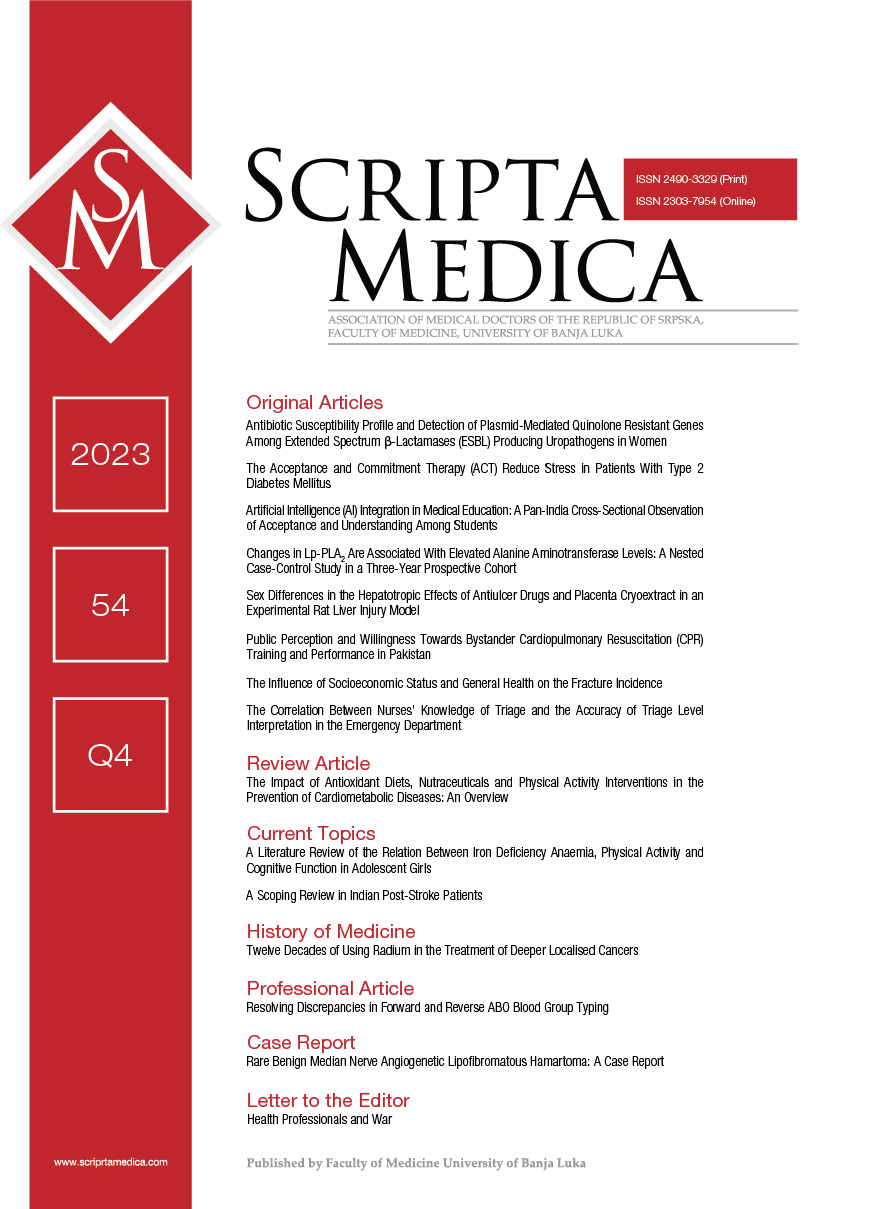The Influence of Socioeconomic Status and General Health on the Fracture Incidence
Sažetak
Background/Aim: There is an association between patient general health, socioeconomic status and fracture incidence. Aim of this study was to demonstrate the relation between the socioeconomic and health status and the occurrence of fractures in Al-Kindy Hospital residents.
Methods: A prospective cross-sectional study was performed by using data collected from fractured patients in Al-Kindy Teaching Hospital / Baghdad orthopaedics outpatient clinic, between 12 December 2021 and 8 March 2022. A 100 patients aged 20 to 75 years were included in this study. The data were collected using a researcher-administered questionnaire, which included items to assess patient’s socioeconomic status (accommodations, occupation, income status, level of education, owing motor vehicle) and assessed patient’s health status (height, weight, presence of chronic disease(s), smoking status, alcohol consumption, water source quality, sun exposure, nutrition status).
Results: A 100 patients from Al-Kindy Teaching Hospital between the age 20-75 participated in the study. The incidence of fractures was higher in younger and more active males (68 %) than females (32 %). Highest percent appeared in lower group of socioeconomic status (58 %) and in lower group of health status (44 %). There was a significant relation between health status and body mass index (BMI). Obese and overweight patient were the more vulnerable to fractures.
Conclusion: Fractures are more likely to happen to people with low socioeconomic status, low general health status and overweight people.
Reference
Witmer DK, Marshall ST, Browner BD. Emergency care of musculoskeletal injuries. In: Townsend CM, Beauchamp RD, Evers BM, Mattox KL, editors. Sabiston textbook of surgery. 20. New York: Elsevier; 2016. pp. 462–504.
Omer W, Al-Hadithi T. Developing a socioeconomic index for health research in Iraq. East Mediterr Health J 2017;23(10):670-7.
Stowasser T, Heiss F, McFadden D, Winter J. "Healthy, Wealthy and Wise?" Revisited: An analysis of the causal pathways from socioeconomic status to health. In: Wise D. Investigations in the Economics of Aging. Cambridge, MA: NBER Books; 2011. p. 267-317.
Weir CB, Jan A. BMI classification percentile and cut off points. 2023 Jun 26. In: StatPearls [Internet]. Treasure Island (FL): StatPearls Publishing. [Cited: 1-Oct-2023]. Available at: https://pubmed.ncbi.nlm.nih.gov/31082114/.
Alswat KA. Gender disparities in osteoporosis. J Clin Med Res 2017 May;9(5):382-7.
Kiebzak GM, Beinart GA, Perser K, Ambrose CG, Siff SJ, Heggeness MH. Undertreatment of osteoporosis in men with hip fracture. Arch Intern Med 2002 Oct 28;162(19):2217-22.
Li W, Keegan TH, Sternfeld B, Sidney S, Quesenberry CP Jr, Kelsey JL. Outdoor falls among middle-aged and older adults: a neglected public health problem. Am J Public Health 2006 Jul;96(7):1192-200.
Lo AX, Rundle AG, Buys D, Kennedy RE, Sawyer P, Allman RM, et al. Neighborhood disadvantage and life‐space mobility are associated with incident falls in community‐dwelling older adults. J Am Geriatr Soc 2016 Nov;64(11):2218-25.
Anjos LA. Body mass index as a tool in the nutritional assessment of adults: a review. Rev Saúde Pública 1992;26:431-6.
Deurenberg P, Weststrate JA, Seidell JC. Body mass index as a measure of body fatness: age- and sex-specific prediction formulas. Br J Nutr 1991 Mar;65(2):105-14.
Romero-Corral A, Montori VM, Somers VK, Korinek J, Thomas RJ, Allison TG, et al. Association of bodyweight with total mortality and with cardiovascular events in coronary artery disease: a systematic review of cohort studies. Lancet 2006;368(9536):666-78.
Adams KF, Schatzkin A, Harris TB, Kipnis V, Mouw T, Ballard-Barbash R, et al. Overweight, obesity, and mortality in a large prospective cohort of persons 50 to 71 years old. NEJM 2006;355(8):763-78.
Flegal KM, Graubard BI, Williamson DF, Gail MH. Excess deaths associated with underweight, overweight, and obesity. JAMA 2005;293(15):1861-7.
Gnudi S, Sitta E, Lisi L. Relationship of body mass index with main limb fragility fractures in postmenopausal women. J Bone Miner Metab 2009;27(4):479-84.
Ong T, Sahota O, Tan W, Marshall L. A United Kingdom perspective on the relationship between body mass index (BMI) and bone health: a cross sectional analysis of data from the Nottingham Fracture Liaison Service. Bone 2014;59:207-10.
Kelsey JL, Samelson EJ. Variation in risk factors for fractures at different sites. Curr Osteoporos Rep 2009;7(4):127-33.
Valentin G, Ravn MB, Jensen EK, Friis K, Bhimjiyani A, Ben-Shlomo Y, et al. Socio-economic inequalities in fragility fracture incidence: a systematic review and meta-analysis of 61 observational studies. Osteoporos Int 2021:1-16.
Crandall CJ, Han W, Greendale GA, Seeman T, Tepper P, Thurston R, et al. Socioeconomic status in relation to incident fracture risk in the Study of Women's Health Across the Nation. Osteoporos Int 2014;25(4):1379-88.
Reyes C, García-Gil M, Elorza JM, Fina-Avilés F, Mendez-Boo L, Hermosilla E, et al. Socioeconomic status and its association with the risk of developing hip fractures: a region-wide ecological study. Bone 2015;73:127-31.
Han S, Jang HD, Choi S, Kim GD, Han K, Lim H, et al. Changes in physical activity and risk of fracture: a Korean nationwide population-based cohort study. Sci Rep 2020 Oct 1;10(1):16266. doi: 10.1038/s41598-020-73495-1.
- Authors retain copyright and grant the journal right of first publication with the work simultaneously licensed under a Creative Commons Attribution License that allows others to share the work with an acknowledgement of the work's authorship and initial publication in this journal.
- Authors are able to enter into separate, additional contractual arrangements for the non-exclusive distribution of the journal's published version of the work (e.g., post it to an institutional repository or publish it in a book), with an acknowledgement of its initial publication in this journal.
- Authors are permitted and encouraged to post their work online (e.g., in institutional repositories or on their website) prior to and during the submission process, as it can lead to productive exchanges, as well as earlier and greater citation of published work (See The Effect of Open Access).

